Use of Different Types of Magnetic Field Sensors in Diagnosing the State of Ferromagnetic Elements Based on Residual Magnetic Field Measurements
Abstract
1. Introduction
1.1. The Current State of Steel Wire Rope Diagnostics
1.2. Aim of this Work
2. Materials and Methods
2.1. Examined Object—Steel Wire Rope
2.2. Self-Magnetic Flux Leakage Method
3. Sensors
3.1. Types of Used Sensors
3.2. Calibration and Validation of Used Sensors
4. Experimental Details
5. Results
6. Discussion
- S1 sensor (Figure 11): Compared to the other sensors, the obtained magnetic induction difference values were minimal—several dozen times lower. The change in the magnetic signal was not recorded at a distance of 25 mm from the sensor—only for a distance of 10 mm. The sensor registered changes in induction in the vicinity of the discontinuity, but these changes were still present in a large area behind the discontinuity. Near the discontinuity, the amplitude of the signal changes was the largest, which allowed for its localization. The recorded changes did not correspond to the natural changes in the induction value (which can be determined based on the measurement results of the S4 sensor). It is very puzzling that the signals differed in opposite directions, i.e., there were different amplitudes. There were additional disturbances in the signal waveform, the reasons for which we cannot determine; however, one of the reasons is probably the vibration of the sensor.
- S2 sensor (Figure 12): We can see an extensive analogy here regarding the comments concerning the S1 sensor, which uses the same measurement method. It is evident here, however, that the signal’s amplitude was lower at this distance from the test object, probably due to the different designs and configurations of the measuring coils. Qualitatively, the course of the recorded signal distribution was very similar to the distribution of the signal from the S1 sensor, but quantitatively, this signal was about twice as small. As in sensor S1, the discontinuity caused changes in the signal, and all the comments made for sensor S1 apply here.
- S3 sensor (Figure 13 and Figure 14): In the case of the S3_1 and S3_2 sensors, we observed the high convergence and repeatability of the measurement. The S3 sensor, in contrast to the S1 and S2 sensors, measures the absolute value of the magnetic induction vector read at a specific point on Earth. The results were several dozen times higher than those of the S1 and S2 sensors. However, the sensor’s sensitivity deserves attention—the damage was detected at 25 mm from the rope (sensors S1 and S2 did not indicate damage at this distance). An apparent signal change could be seen concerning the signal for the rope with damage. Compared to the distribution of induction measured for the rope without discontinuities, the introduced discontinuity caused a change in the distribution in the form of a local anomaly of a sinusoidal function. The location of the discontinuity coincided with the local minimum of this anomaly. Unfortunately, this sensor also has its limitations. For the distance between sensors S3_1 and S3_2 equal to 10 mm (as in series 1 and 2) and the distance of sensors from the rope also equal to 10 mm (third series of measurements), the measurement range was exceeded, which made it impossible to obtain a physically possible induction distribution for this case. The sensors had to be moved horizontally to a distance of 50 mm, as shown in Figure 10 (series 3). In most measurement cases, the induction distributions measured by the S3_1 and S3_2 sensors were similar in quality, with quantitative differences. In one case, the results for sensor S3_2 differed both qualitatively and quantitatively.
- S4 sensor (Figure 15, Figure 16 and Figure 17): The S4 sensor seems to be the most promising in detecting discontinuities in wire ropes. It is worth noting that changes resulting from discontinuities in the steel rope were visible at 10 mm and 25 mm distances. Moreover, these changes were visible in every component of the signal. It is also worth noting that the direction of the measurement had no effect on the obtained result, which was the same for the two opposite directions. The magnetic anomaly caused by discontinuities for each component caused a characteristic distribution disorder. In the location of a discontinuity, tangential components (parallel and perpendicular to the axis of the rope—references) have local extremes. In the distribution of the normal component, there are two local extremes (maximum and minimum), and the distribution of values in its vicinity has a sinusoidal shape. The distributions of the tangent components parallel to the rope axis and the normal (radial) tangent provide the most visible diagnostic information.
7. Conclusions
Author Contributions
Funding
Institutional Review Board Statement
Informed Consent Statement
Data Availability Statement
Conflicts of Interest
References
- Zhang, Y.; Jing, L.; Chen, C.; Bai, X.; Tan, J. A comprehensive study of the magnetic concentrating sensor for the damage detection of steel wire ropes. Mater. Res. Express 2020, 7, 096102. [Google Scholar] [CrossRef]
- Zhou, P.; Zhou, G.; Zhu, Z.; He, Z.; Ding, X.; Tang, C. A Review of Non-Destructive Damage Detection Methods for Steel Wire Ropes. Appl. Sci. 2019, 9, 2771. [Google Scholar] [CrossRef]
- Mazurek, P. A Comprehensive Review of Steel Wire Rope Degradation Mechanisms and Recent Damage Detection Methods. Sustainability 2023, 15, 5441. [Google Scholar] [CrossRef]
- Zhang, J.; Tan, X.; Zheng, P. Non-Destructive Detection of Wire Rope Discontinuities from Residual Magnetic Field Images Using the Hilbert-Huang Transform and Compressed Sensing. Sensors 2017, 17, 608. [Google Scholar] [CrossRef] [PubMed]
- Zhang, J.; Zheng, P.; Tan, X. Recognition of Broken Wire Rope Based on Remanence using EEMD and Wavelet Methods. Sensors 2018, 18, 1110. [Google Scholar] [CrossRef]
- Lei, G.; Xu, G.; Zhang, X.; Zhang, Y.; Song, Z.; Xu, W. Study on Dynamic Monitoring of Wire Rope Tension Based on the Particle Damping Sensor. Sensors 2019, 19, 388. [Google Scholar] [CrossRef]
- Zhang, Y.; Jing, L.; Xu, W.; Zhan, W.; Tan, J. A Sensor for Broken Wire Detection of Steel Wire Ropes Based on the Magnetic Concentrating Principle. Sensors 2019, 19, 3763. [Google Scholar] [CrossRef]
- Zhang, G.; Tang, Z.; Zhang, J.; Gui, W. Convolutional Autoencoder-Based Flaw Detection for Steel Wire Ropes. Sensors 2020, 20, 6612. [Google Scholar] [CrossRef]
- Zhang, G.; Tang, Z.; Fan, Y.; Liu, J.; Jahanshahi, H.; Aly, A.A. Steel Wire Rope Surface Defect Detection Based on Segmentation Template and Spatiotemporal Gray Sample Set. Sensors 2021, 21, 5401. [Google Scholar] [CrossRef]
- Tang, J.; Wang, R.; Qiu, G.; Hu, Y.; Kang, Y. Mechanism of Magnetic Flux Leakage Detection Method Based on the Slotted Ferromagnetic Lift-Off Layer. Sensors 2022, 22, 3587. [Google Scholar] [CrossRef]
- Tian, J.; Wang, W.; Wang, H.; Bai, Q.; Zhou, Z.; Li, P. Enhancing Wire-Rope Damage Signals Based on a Radial Magnetic Concentrator Bridge Circuit. Sensors 2022, 22, 3654. [Google Scholar] [CrossRef] [PubMed]
- Zhang, J.; Shi, Y.; Huang, Y.; Liang, C.; Dong, Y.; Kang, Y.; Feng, B. A Displacement Sensing Method Based on Permanent Magnet and Magnetic Flux Measurement. Sensors 2022, 22, 4326. [Google Scholar] [CrossRef] [PubMed]
- Farag, H.E.; Toyserkani, E.; Khamesee, M.B. Non-Destructive Testing Using Eddy Current Sensors for Defect Detection in Additively Manufactured Titanium and Stainless-Steel Parts. Sensors 2022, 22, 5440. [Google Scholar] [CrossRef]
- Onur, Y.A.; İmrak, C.E.; Onur, T.Ö. Discarding lifetime investigation of a rotation resistant rope subjected to bending over sheave fatigue. Measurement 2019, 142, 163–169. [Google Scholar] [CrossRef]
- Zhou, P.; Zhou, G.; He, Z.; Tang, C.; Zhu, Z.; Li, W. A novel texture-based damage detection method for wire ropes. Measurement 2019, 148, 106954. [Google Scholar] [CrossRef]
- Ni, Y.; Zhang, Q.; Xin, R. Magnetic flux detection and identification of bridge cable metal area loss damage. Measurement 2021, 167, 108443. [Google Scholar] [CrossRef]
- Liu, S.; Sun, Y.; Jiang, X.; Kang, Y. Comparison and analysis of multiple signal processing methods in steel wire rope defect detection by hall sensor. Measurement 2021, 171, 108768. [Google Scholar] [CrossRef]
- Baader, J.E.; Casalbuoni, S. Magnetic field reconstruction using the pulsed wire method: An accuracy analysis. Measurement 2022, 193, 110873. [Google Scholar] [CrossRef]
- Ebbeni, M.; Gehlot, M.; Holz, M.; Tarawneh, H. A flexible approach on pulsed wire magnetic measurement method. Measurement 2022, 199, 111438. [Google Scholar] [CrossRef]
- Sheinker, A.; Frumkis, L.; Ginzburg, B.; Salomonski, N.; Kaplan, B.-Z. Magnetic Anomaly Detection Using a Three-Axis Magnetometer. IEEE Trans. Magn. 2009, 45, 160–167. [Google Scholar] [CrossRef]
- Mazurek, P.; Kwaśniewski, J.; Roskosz, M.; Siwoń-Olszewski, R. The use of a magnetic flux leakage in the assessment of the technical state of a steel wire rope subjected to bending. J. KONBiN 2018, 48, 493–513. [Google Scholar] [CrossRef]
- Zhang, D.; Zhang, E.; Pan, S.; Yan, X.; Gao, W. Fast Quantitative Method to Detect the Cross-Sectional Loss of Wire Rope Defects. IEEE Trans. Instrum. Meas. 2021, 70, 6004411. [Google Scholar] [CrossRef]
- Mazurek, P.; Roskosz, M. Influence of the Earth’s magnetic field on the diagnosis of steel wire rope by passive magnetic methods. J. Magn. Magn. Mater. 2021, 547, 168802. [Google Scholar] [CrossRef]
- Mouradi, H.; El Barkany, A.; Biyaali, A. Investigation on the main degradation mechanisms of steel wire ropes: A literature review. J. Eng. Appl. Sci. 2016, 11, 1206–1217. [Google Scholar]
- Liu, Z.; Liu, S.; Xie, C.; Bai, G. Non-Invasive Force Measurement Based on Magneto-Elastic Effect for Steel Wire Ropes. IEEE Sens. J. 2021, 21, 8979–8987. [Google Scholar] [CrossRef]
- Tytko, A. Liny Stalowe: Budowa, Właściwości, Eksploatacje, Zastosowania; Wydawnictwo Naukowe PWN: Warsaw, Poland, 2021. [Google Scholar]
- Mazurek, P.; Roskosz, M.; Kwaśniewski, J. Novel Diagnostic of Steel Wire Rope with Passive Magnetic Methods. IEEE Magn. Lett. 2022, 13, 2500705. [Google Scholar] [CrossRef]
- Mazurek, P.; Roskosz, M. Residual magnetic field as a source of information about steel wire rope technical condition. Open Eng. 2022, 12, 640–646. [Google Scholar] [CrossRef]
- Feng, B.; Wu, J.; Tu, H.; Tang, J.; Kang, Y. A Review of Magnetic Flux Leakage Nondestructive Testing. Materials 2022, 15, 7362. [Google Scholar] [CrossRef]
- Qu, Y.; Zhou, J.; Liu, R.; Liao, L.; Zhao, Q. Research on the Detection of the Broken Wire Damage of a Cable in the Circumferential Directions Based on Self-magnetic Flux Leakage. KSCE J. Civ. Eng. 2021, 25, 879–890. [Google Scholar] [CrossRef]
- Lee, J.; Wang, D.; Dharmawan, I.D.M.O. Theoretical Model of Self-Magnetic Flux Leakage and Its Application in Estimating the Depth Direction of a Fatigue Crack. Appl. Sci. 2023, 13, 533. [Google Scholar] [CrossRef]
- Dubov, A.A. A study of metal properties using the method of magnetic memory. Met. Sci. Heat Treat. 1997, 39, 401–405. [Google Scholar] [CrossRef]
- Dubov, A.A. Development of a metal magnetic memory method. Chem. Pet. Eng. 2012, 47, 837–839. [Google Scholar] [CrossRef]
- Dubov, A.A. Detection of Metallurgical and Production Defects in Engineering Components Using Metal Magnetic Memory. Metallurgist 2015, 59, 164–167. [Google Scholar] [CrossRef]
- Bao, S.; Jin, P.; Zhao, Z.; Fu, M. A Review of the Metal Magnetic Memory Method. J. Nondestruct. Eval. 2020, 39, 11. [Google Scholar] [CrossRef]
- Firdaus, S.M.; Arifin, A.; Abdullah, S.; Singh, S.S.K.; Nor, N.M. Fatigue Life Assessment of API Steel Grade X65 Pipeline Using a Modified Basquin Parameter of the Magnetic Flux Leakage Signal. Materials 2023, 16, 464. [Google Scholar] [CrossRef]
- Psuj, G. Magnetic Field Multi-Sensor Transducer for Detection of Defects in Steel Components. IEEE Trans. Magn. 2017, 53, 6200604. [Google Scholar] [CrossRef]
- Chen, Q.; Zhang, J.; Li, B. Finite Element Simulation and Test of Metal Magnetic Memory Detection of Wire Rope Under Weak Magnetic Field. J. Fail. Anal. Prev. 2023, 23, 351–360. [Google Scholar] [CrossRef]
- Zhang, H.; Li, H.; Zhou, J.; Tong, K.; Xia, R. A multi-dimensional evaluation of wire breakage in bridge cable based on self-magnetic flux leakage signals. J. Magn. Magn. Mater. 2023, 566, 170321. [Google Scholar] [CrossRef]
- Deng, R.; Su, S.; Wang, W.; Zuo, F.; Li, J.; Liu, X. Research on the force-magnetic coupling of steel wire and defect evaluation based on self-magnetic flux leakage effect. J. Magn. Magn. Mater. 2023, 570, 170505. [Google Scholar] [CrossRef]
- van der Horst, M.P.; van Kreveld, S.L.; Kaminski, M.L. Effect of stress-induced magnetization on crack monitoring by self magnetic flux leakage method. Int. J. Appl. Electromagn. Mech. 2019, 60, 113–130. [Google Scholar] [CrossRef]
- Mazurek, P.; Roskosz, M.; Kwaśniewski, J. Influence of the Size of Damage to the Steel Wire Rope on the Magnetic Signature. Sensors 2022, 22, 8162. [Google Scholar] [CrossRef] [PubMed]
- Mazurek, P.; Roskosz, M.; Kwaśniewski, J.; Wu, J.; Schabowicz, K. Detecting Discontinuities in Steel Wire Ropes of Personal Lifts Based on the Analysis of Their Residual Magnetic Field. Sustainability 2022, 14, 14641. [Google Scholar] [CrossRef]
- Xia, R.; Zhou, J.; Zhang, H.; Liao, L.; Zhao, R.; Zhang, Z. Quantitative Study on Corrosion of Steel Strands Based on Self-Magnetic Flux Leakage. Sensors 2018, 18, 1396. [Google Scholar] [CrossRef] [PubMed]
- Xia, R.; Zhang, H.; Zhou, J.; Liao, L.; Zhang, Z.; Yang, F. Probability evaluation method of cable corrosion degree based on self-magnetic flux leakage. J. Magn. Magn. Mater. 2021, 522, 167544. [Google Scholar] [CrossRef]
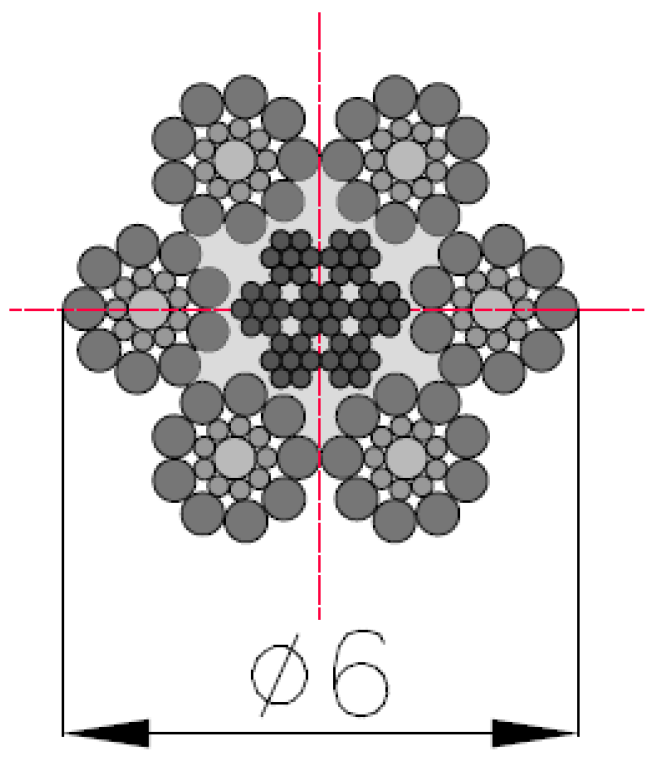

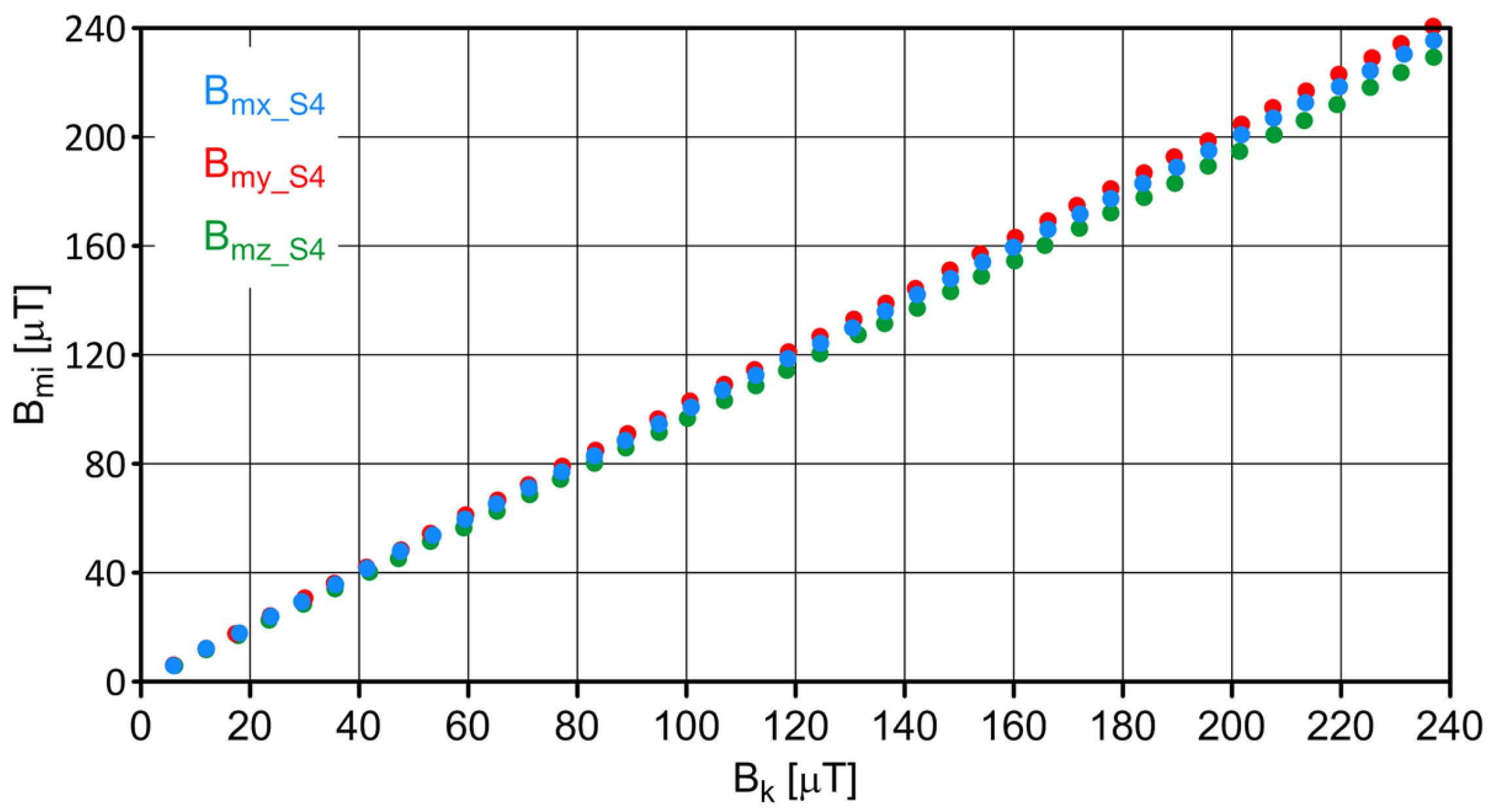

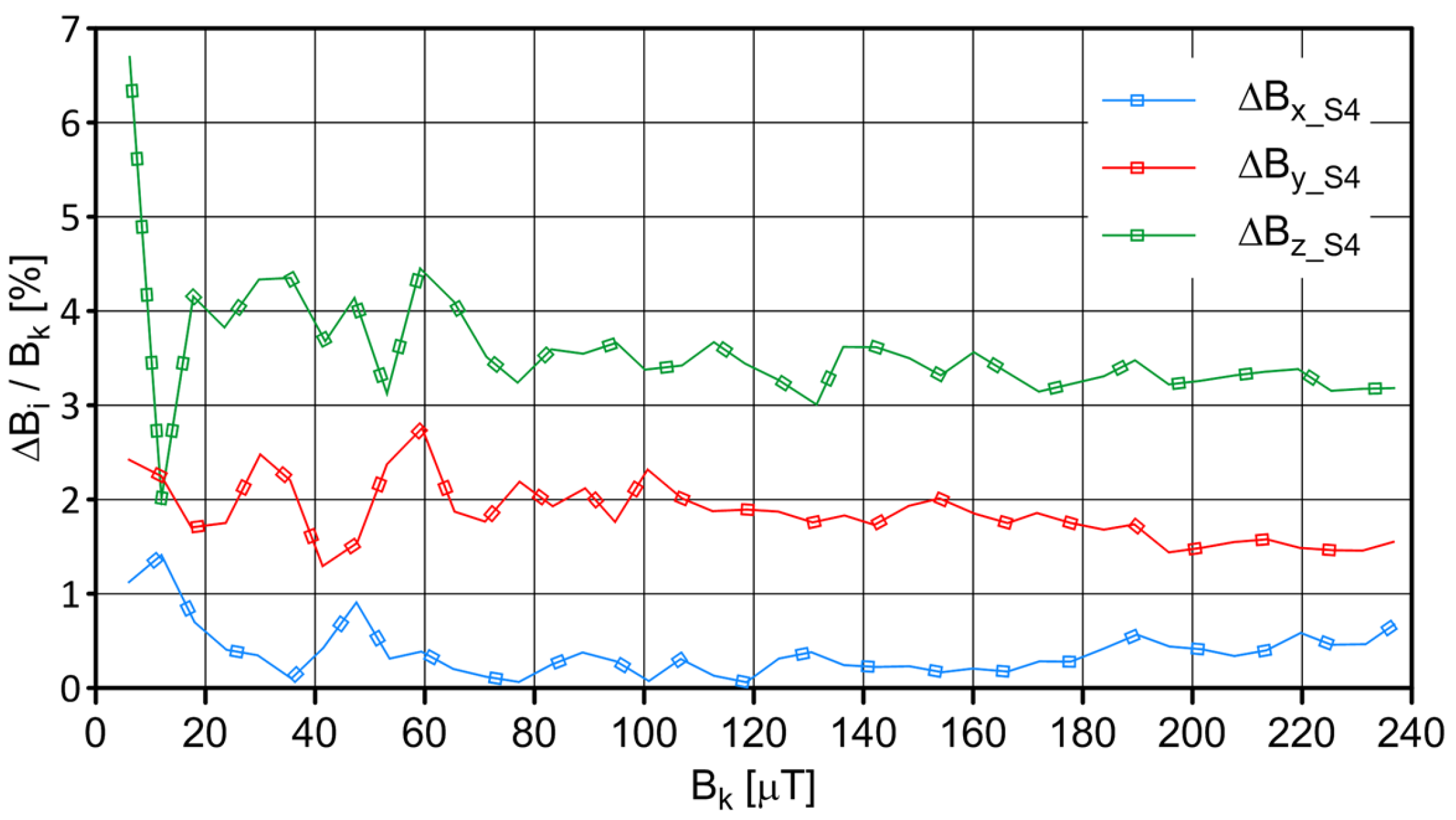




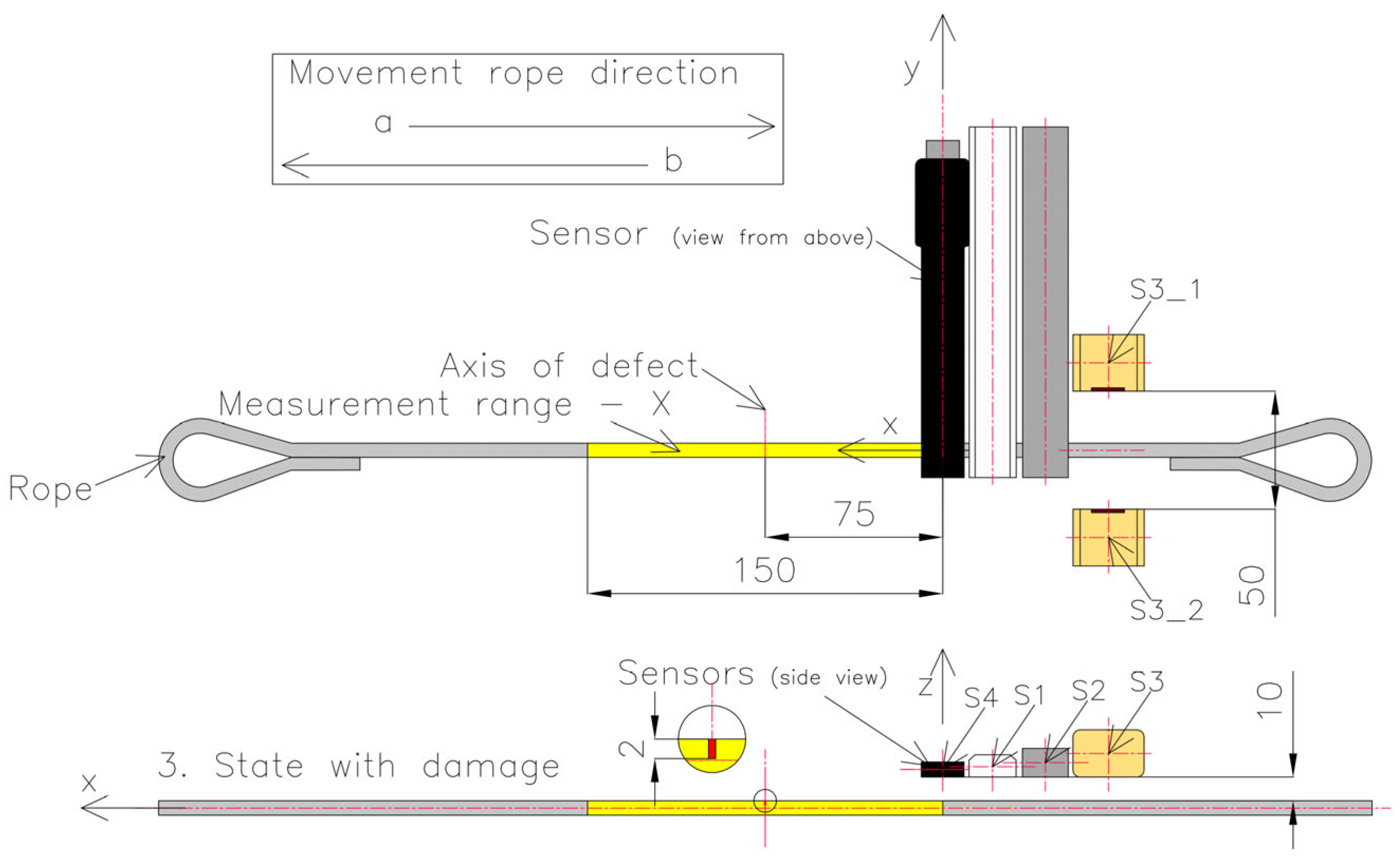

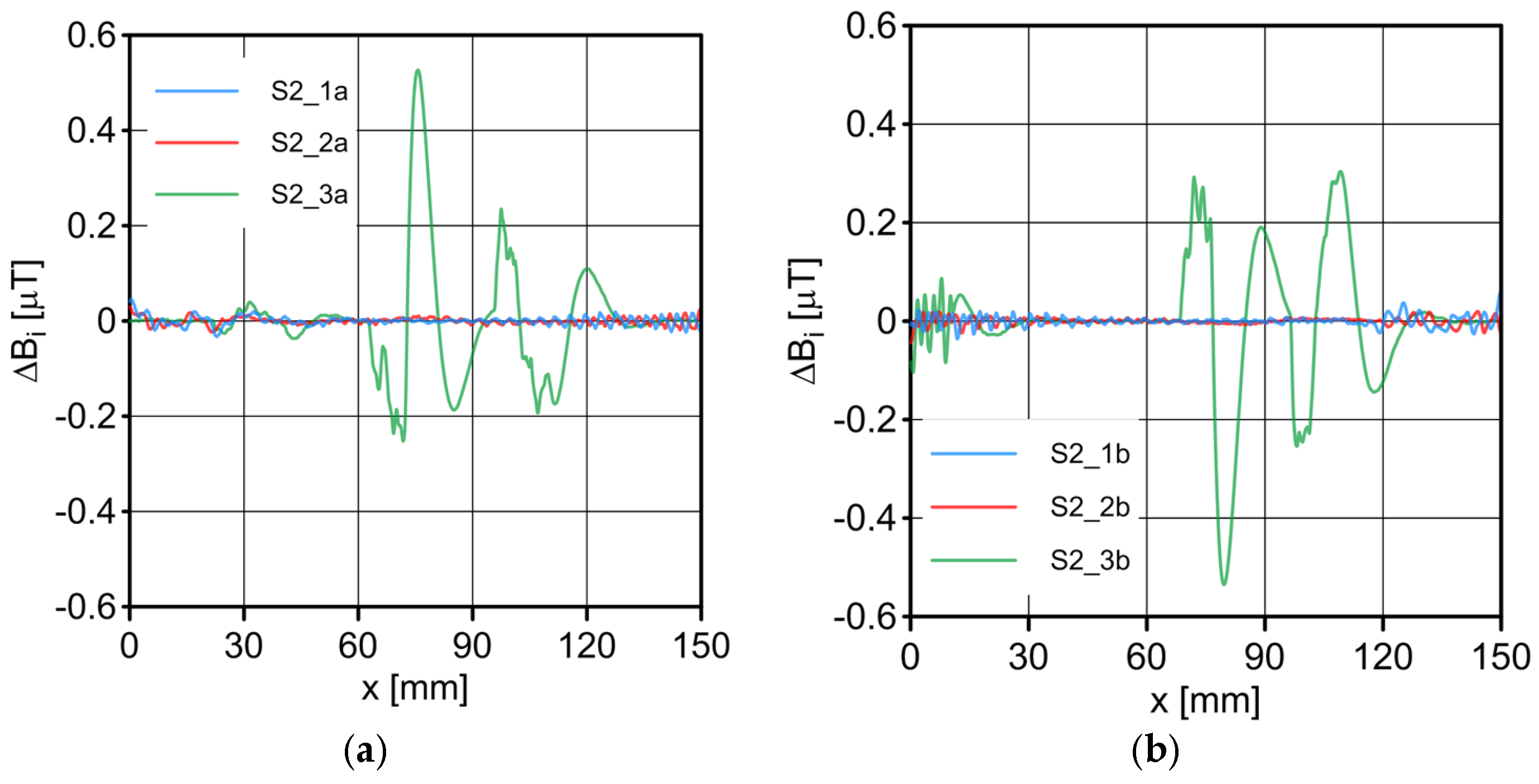


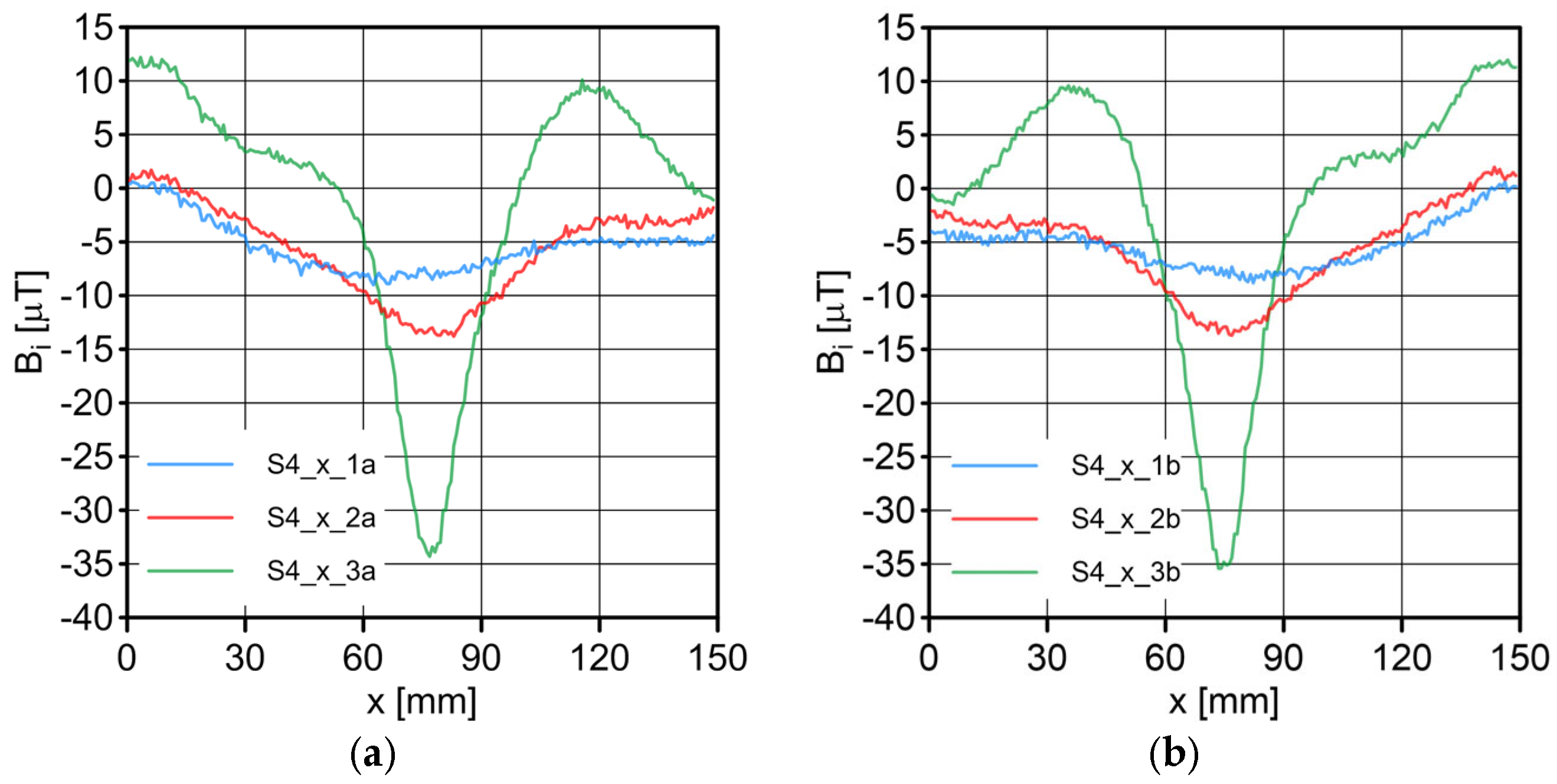
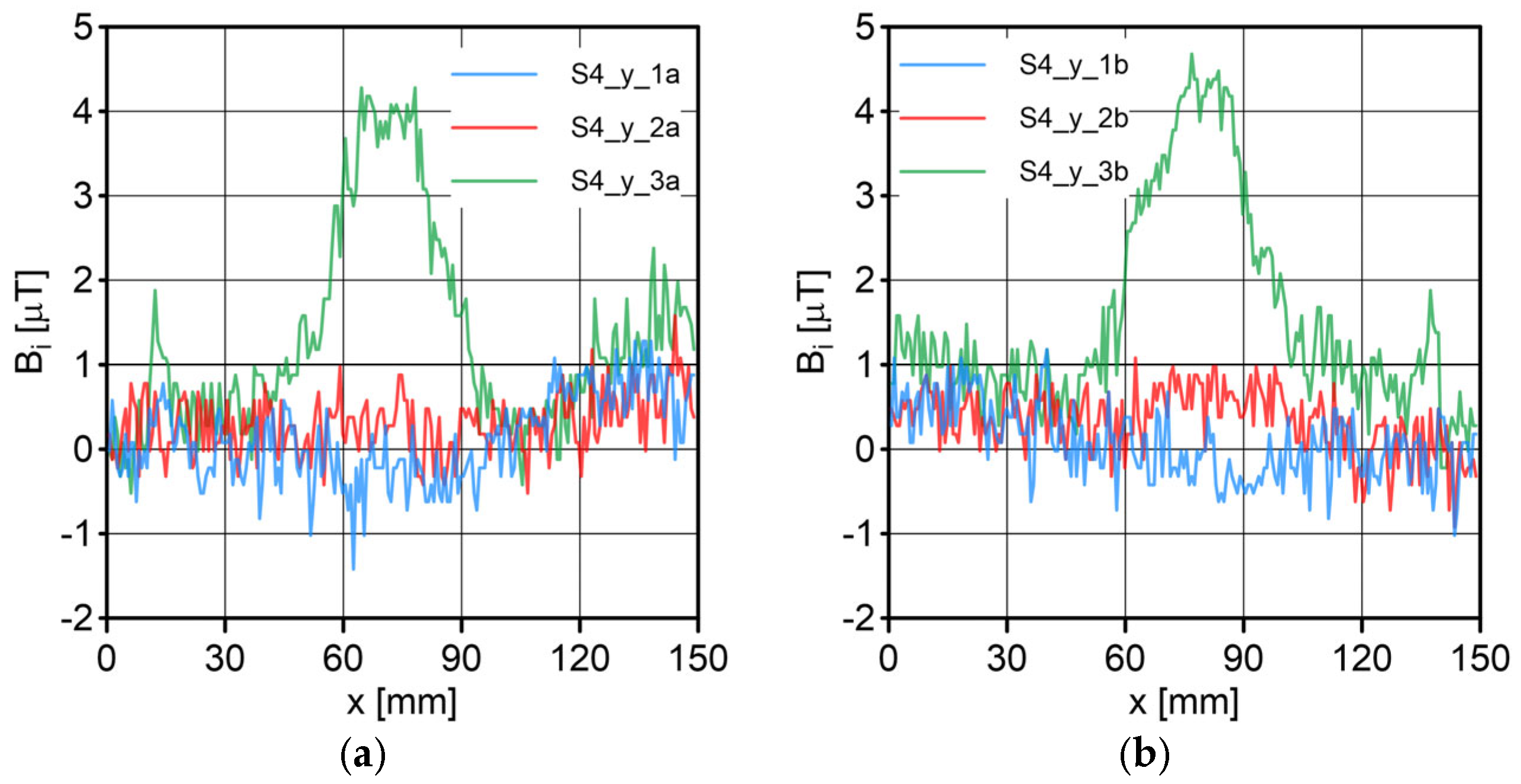

| No. | Manufacturer’s Designation | Producer | Measurement Phenomenon Used | Sensor Characteristics (According to Information from Producers) | Comments | ||
|---|---|---|---|---|---|---|---|
| Typical Scale Range | Sensitivity | Noise | |||||
| S1 | MI-CB-1DJ-S-B-USB | Aichi Steel (Japan) | One-axis magnetoimpedance magnetometer | 2μT pp | 5.0 V/μT | 1 nT/1σ | Single sensing element |
| S2 | MI-CB-1DJ-D-B-USB | Aichi Steel (Japan) | One-axis magnetoimpedance magnetometer | A line of differential sensing elements | |||
| S3 | Micro-Fabricated Atomic Magnetometer | Geometrics (USA) | Miniature scalar magnetometer evaluation module with two laser-pumped cesium sensors | 20–100 µT | 1 pT/ | 5 pT/ | It consists of two independent sensors labeled S3_1 and S3_2 |
| S4 | SpinMeter-3D USB 3 Axis Magnetometer | Micro Magnetics (USA) | Digital triaxial magnetometer based on quantum magnetic tunnel junctions (MTJs) and magnetoresistance tunneling effect (TMR) | ±1000 µT | 0.10 µT | 0.25 µT rms (minimum) | Measures the value of magnetic induction in 3 axes marked as S4_x, S4_y, S4_z |
Disclaimer/Publisher’s Note: The statements, opinions and data contained in all publications are solely those of the individual author(s) and contributor(s) and not of MDPI and/or the editor(s). MDPI and/or the editor(s) disclaim responsibility for any injury to people or property resulting from any ideas, methods, instructions or products referred to in the content. |
© 2023 by the authors. Licensee MDPI, Basel, Switzerland. This article is an open access article distributed under the terms and conditions of the Creative Commons Attribution (CC BY) license (https://creativecommons.org/licenses/by/4.0/).
Share and Cite
Roskosz, M.; Mazurek, P.; Kwaśniewski, J.; Wu, J. Use of Different Types of Magnetic Field Sensors in Diagnosing the State of Ferromagnetic Elements Based on Residual Magnetic Field Measurements. Sensors 2023, 23, 6365. https://doi.org/10.3390/s23146365
Roskosz M, Mazurek P, Kwaśniewski J, Wu J. Use of Different Types of Magnetic Field Sensors in Diagnosing the State of Ferromagnetic Elements Based on Residual Magnetic Field Measurements. Sensors. 2023; 23(14):6365. https://doi.org/10.3390/s23146365
Chicago/Turabian StyleRoskosz, Maciej, Paweł Mazurek, Jerzy Kwaśniewski, and Jianbo Wu. 2023. "Use of Different Types of Magnetic Field Sensors in Diagnosing the State of Ferromagnetic Elements Based on Residual Magnetic Field Measurements" Sensors 23, no. 14: 6365. https://doi.org/10.3390/s23146365
APA StyleRoskosz, M., Mazurek, P., Kwaśniewski, J., & Wu, J. (2023). Use of Different Types of Magnetic Field Sensors in Diagnosing the State of Ferromagnetic Elements Based on Residual Magnetic Field Measurements. Sensors, 23(14), 6365. https://doi.org/10.3390/s23146365







